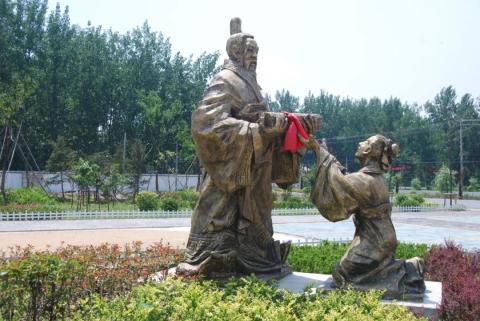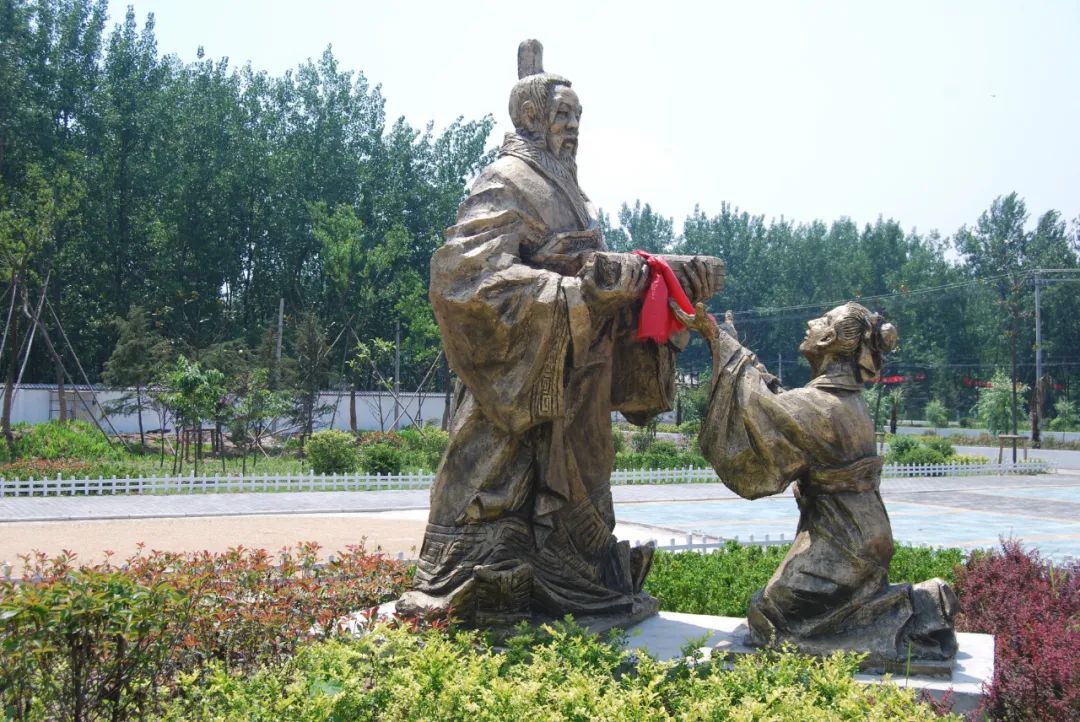
Jingxiang’s Travel Notes Chapter 23丨 The Ancient Road in the Wasteland
Time: June 12-13, 2013
Location: Suining County, Xuzhou City, Jiangsu Province
Wasteland ancient road
The day I arrived in Xuzhou from Tongliao was the Dragon Boat Festival, which was June 12, 2013. In fact, I did not remember that this day was the Dragon Boat Festival. After getting off the train, I went straight to Suining to find Principal Qiu. At her invitation, I gave a Chinese studies class in Suining that night.
Of course, the purpose of my coming here is to travel. Suining is worth a visit because it is an ancient battlefield full of war relics from the Three Kingdoms period. However, despite the many battles, it was difficult to find scenic spots.
The next day, we went directly to Gucai Town. Principal Qiu asked a local old comrade named Cui to be my guide, and he would guide us in searching for the ruins of the Han Dynasty.
Lao Cui asked me what attractions I wanted to see.
"I want to go to Xiapi to see the place where Guan Yu surrendered to Cao Cao." In fact, this is Xiapi.
In fact, I just wanted to see the place that Luo Guanzhong had whitewashed. However, Lao Cui hesitated: "That place should be in Pizhou." Obviously Lao Cui didn't know where it was.
"Then just watch whatever you want." I can't force others to do anything, right?
Lao Cui said: "Liuhou Temple is worth seeing."
"Isn't it just an ancestral hall?" I am not very interested in places like temples and ancestral halls, and since I didn't understand what Lao Cui said in Suining, I felt that the place was of little significance.
Lao Cui also knew that I couldn't hear what he said, so he continued: "That's where the bridge enters the shoes."
"Ah?" When I heard what he said clearly, I couldn't help but said in surprise: "I want to see this."
There is no need to write down the story of Yuanqiao Jinlu, it is a household name. Huang Shigong deliberately took off his shoes under the bridge, and arrogantly asked Zhang Liang to pick them up and help him put them on. As a result, Zhang Liang did so. So, Huang Shigong gave Zhang Liang a book: "If you read this book, you can become a teacher of the king. In 10 years, the world will be in chaos. You can use this book to build a country; come to see me again in 13 years." After that, he walked away.

How can you miss such a place with a story? But when I came to the bridge excitedly, I was surprised by a brand-new cement bridge: "Is this the bridge where Zhang Liang picked up Huang Shigong's shoes?" I obviously didn't believe it.

Lao Cui said: "The old bridge no longer exists." He pointed to the woods not far away and said: "Well, just over the woods, it is already woodland."

It turns out that Xinqiao is Xinqiao, not the original Yuanqiao! Okay, let’s go into the scenic spot and have a look.
However, the scenic spot is under construction and has not yet been opened to the public. The scenic spot is full of wheat that has just been harvested from the fields, while the gate of Liuhou Temple is closed.


Facing these submerged ancient roads, I thought of an ancient village somewhere, and couldn't help but sigh: It doesn't make much sense for us to rebuild a new one for the submerged monuments, but it is still understandable. The most distressing thing is that in some places, dilapidated monuments have been built into new villages! I really don’t know whether the law should pursue the crime of destroying cultural relics for this kind of ignorance?
Seeing that I was a little disappointed, Lao Cui said that there was another place very close to here, but he said it many times and I couldn't hear it clearly because the people here all spoke their hometown dialect which is closer to Mandarin. I just listened. Going to that place is called "Baimong Road". I think we'll find out when we get there.
The car was walking on the embankment and was stopped by Lao Cui at the entrance of a water gate. I looked up and saw a few big characters on the water gate, which made me realize that what Lao Cui just said was "White Gate Tower"!

This reminds me of the plot about Lu Bu's murder in "The Romance of the Three Kingdoms", which is Chapter 19: "Cao Cao fought fiercely in Xiapi City, and Lu Bu died in Baimen Tower." I asked Lao Cui: "Is this where Lu Bu was killed?" Lao Cui replied: "This is the Baimen Tower. The specific location where he was killed cannot be verified now."
Do you understand now? There are indeed many places with stories here, but after all the changes, we could no longer find the location, so we walked back.
This day was the market day in Gucai Town. When we came out of Baimenlou, the market crowds had begun to disperse, and bustling people could still be seen on the streets.

However, the most eye-catching thing is a stone monument in the town. Lao Cui specially suggested that I get out of the car and go have a look.

This monument was erected for an ancient locust tree, and all I could see was half of the dead tree.

Just when I thought they were making a fuss, an old man passing by took the initiative to be the guide. It turns out that it takes three big men to hug this tree before it dies. Wow! No wonder a monument should be erected for it.
However, the monument was not only built because of its size. According to the inscription, Zhang Fei often led his horse in this locust tree. Celebrities are different, and the place where they lead their horses has become a scenic spot.

After the Yellow River burst its banks several times, the ancient battlefield has long been changed beyond recognition. You can never imagine that the bridge now may be the road back then, and the bridge back then is now gone even over the river.

Lao Cui said hello to the people inside, and our car drove in.
After Lao Cui's introduction, I found out that this was a household named Hua, which was called "Hua Family Courtyard". For such a large courtyard, one can imagine the wealth of the owner. Could it be that I was allowed to visit the home of a rich man?
This question was quickly revealed by the introduction:

It turns out that the owner is still a red descendant! More important, however, are the artifacts collected by this red descendant.
Xuzhou was a strategic location during the Three Kingdoms period. Farmers working on this ancient battlefield would occasionally dig up grave objects. At that time, farmers only knew that gold, silver and jewelry were valuable treasures, so they threw away the jars and jars containing gold, silver and jewelry. On one side, the flower owners picked up their discarded pots and jars and later built this exhibition hall.

Many of these jars and jars are antiques from the Three Kingdoms period or the Pre-Qin period. It is estimated that the people who threw away the jars are now filled with regret. Each of them is priceless. How can the gold, silver and jewelry in the jars be enough? Comparable? Of course, I guess the Hua family won’t release the real thing to attract thieves, so it would be nice to let you see the imitation.
The Huajia Courtyard is very large. If only these "antiques" are on display (in fact, some genuine items are considered antiques even though they are not very old), then there is no need for six large exhibition halls on the upper and lower floors. His collection is no longer limited to The collection includes antiques from the Han Dynasty and the pre-Qin period, including calligraphy and paintings, modern commemorative objects and even photographs.

This water cup bears witness to the history of the Cultural Revolution:

A spacious exhibition hall displays daily necessities that have been eliminated by the development of productivity:

The walls are hung with commemorative items, and obsolete utensils, such as marching kettles, are placed on the floor. Curiously, a modern revival of cross-stitch is also on display.
In short, there is everything, even the copper bull on Suining County’s landmark building “Tongniu Lantern Square” is included:

This is no ordinary cultural relic! In November 1975, Suining unearthed this copper bull lamp in a Han tomb that could only be used by prominent families in the Han Dynasty (this could not be authentic). Kissinger was amazed by its ingenious design, so , Suining County built the Tongniu Lantern Square as the symbol of Suining:

In addition to the eye-opening displays, there was one person who left me in awe.
I am naturally stupid about calligraphy and painting, but I like couplets, so I will naturally stop in front of them: "The thoughts are floating in the clouds, and the poems are embedded in the paintings." Wonderful!

When I looked at the calligrapher's signature, I couldn't believe that the old Cui standing next to me, who couldn't even speak Mandarin accurately, turned out to be a calligrapher!

Lao Cui (the old man in the picture above) pointed to a shining silver calligraphy work and asked me to guess: "What is this written with?"

Without thinking, I said, "Silver powder." Lao Jie laughed and said, "It's cut from a can."
Oh my gosh! How much effort it takes!
It seems that no matter ancient or modern times, there are some masters hidden among the people, and of course it is not limited to martial arts.
That night, I set out on my way home with a heavy harvest.
Preview of the next chapter: After finishing the trip to Northeast China, I also took a trip to the Central Plains. Next, we will not follow chronological order, but geographical location, starting from Sanya, Hainan, all the way north, and travel with me to the north and south of China. The next article starts from the Miao Village in Wuzhishan City, Hainan - "The Style of the Miao Village".
